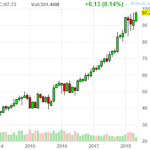Wall Street Journal columnist Holman Jenkins writes frequently about Tesla. He is skeptical that Tesla will survive as it is currently constituted, as am I. His column from June 22, 2018, titled “A Tesla Crackup Foretold” states why he is skeptical, as you might deduce from the title. Jenkins’ prose is sometimes dense, so I will try to translate it.

Government Policy
Teslas have been made more attractive to purchase for consumers because of a $7,500 Federal tax credit. Some states have additional tax credits. However, the Federal tax credit will start to go away after Tesla sells its 200,000’th car, which is expected later this year. Thereafter, the Federal tax credit will be reduced over time and will ultimately go away entirely. Tax credits are better than a price reduction on the car because tax credits directly reduce the purchaser’s taxable income.
Now, ironically, according to Holman Jenkins, it is government policy in a different way that could whack Tesla. The Federal government sets mileage and emissions standards at the automaker level, not at the individual auto level. If an automaker (such as GM) wants to sell a lot of gas-guzzling SUV’s and pickups, that is fine with the government, as long as the same automaker also sells enough zero-emission vehicles to offset the high-emission big vehicles. That’s why GM sells the Volt and now the Bolt, and why GM doesn’t much care about the profitability of the Volt/Bolt because GM more than makes up for the losses through those vehicles via profits in their large vehicles. Tesla doesn’t have the option of using their e-vehicles as a loss leader; Tesla must make money (eventually) on its e-vehicles because that’s all they have.
Tent
Although Tesla continues to be considered the best electric vehicle option available, other e-vehicles are improving, and they are available at a better price relative to Tesla, and there is little motivation for the other automakers to raise e-vehicle prices as long as they are making money by selling other vehicles while complying with Federal emission standards. So, whereas government policy and incentives have favored Tesla heretofore, it will harm Tesla going forward. This is one reason Tesla’s CEO Elon Musk has become more aggressive in his earnings calls and through his Twitter account, and it is also why Tesla just announced it was laying off 9% of its management team. Tesla needs to become cash flow positive and soon because they need to service the estimated $10 Billion of debt on their balance sheet. Tesla is having well-documented problems meeting production for its new Model 3 and they just erected a big tent in their parking lot to create more room for Model 3 production. It is California, but a tent? How can you ensure quality control if you are building in a tent? Check it out:

IMO
Elon Musk is brilliant. He is distracted by a lot of other businesses and projects (Solar City, Space X, Boring, Hyperloop), but Tesla’s production and cash flow situation seems to have his full attention right now. I believe Tesla will either need to acquire a division that spins off enough cash flow to prop up the electric car business, or it will itself be acquired (maybe by Apple? Just a guess). I don’t expect the Tesla auto to disappear with the rollback of the Federal tax credit, but I do expect Tesla’s business model to be different within 2 years. I don’t advocate shorting Tesla because Musk is so talented, and if Tesla is acquired its stock could run up, but I am not bullish on Tesla as it is currently constituted.







